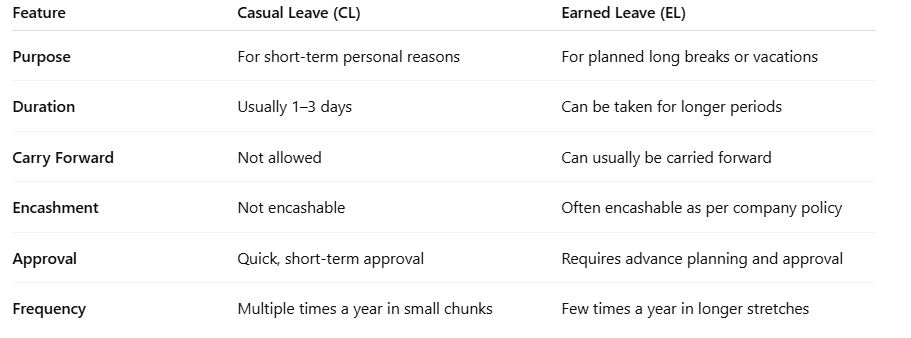What Is a Casual Leave? Its Meaning, Duration, and Rules Explained
Each employee has a right to a break and it is not only to go on a vacation but also for personal and unforeseen reasons. Casual Leave (CL) is one option for an employee to take time off work for brief intervals so that the flow of work is not interrupted. CL is one of the most common type of leave taken because it helps employees take a pause from work for a reasonable duration.
This article discusses casual leave meaning, duration, rules, policy, differences and implication of earned leave, and also attempts to answer some common queries.
CL Leave Full Form and Meaning
CL stands for Casual Leave
Casual Leave is a type of short-term leave that an employee takes for personal, urgent, and unforeseen issues like some family functions, personal work, or unexpected things that arise.
Casual Leave is not meant for an employee to take extended vacations like earned or annual leave, and it is to purpose occasional absences. It helps an employee to achieve a balance between personal commitments and office work responsibilities.
Reasons for Taking Casual Leave
Employers provide casual leave for genuine non-recurring reasons. Some reasons include:
- Family or social functions (weddings, birthdays, etc.)
- Personal errands (bank work, house shifting, etc.)
- Short medical needs or doctor visits
- Illness or emergency at home
- Religious observances or festivals
- Last minute travels or personal obligations
Hence, casual leave is meant to address minor necessary absences that come up at short notice.
Expectations for Casual Leave
Although rules for casual leave may differ from one company to another, most organizations will have the following expectations:
If leave is planned, prior approval needs to be obtained. For emergencies, employees should notify HR or the reporting manager at the earliest opportunity.
Casual leave should not be combined with other forms of leave (earned or sick leave) unless company policy expressly permits it.
Unused casual leave typically expires at the end of the year and is unavailable for carry over.
Casual leave may be taken for the entire day, a half day, or for a maximum of 3 consecutive days (this depends on the HR policy of the company).
Employees are expected to uphold the discipline of attendance. Taking frequent short leaves may be considered in performance evaluations.
Is Casual Leave Paid?
Yes, casual leave is a paid leave.
Employees taking casual leave will receive their full salary, but when an employee takes leave without pay, they will go beyond their allotted days. Unpaid leave is taken when casual leave days have been exhausted.
Every company policy will be different, and local labor laws will make an impact as to how many casual leave days an employee is given.
Most companies in India will provide between 6 to 12 days of casual leave each year, and these will be given monthly, quarterly, and on other distributions.
For example, government employees in India get 8 casual leave days for the year, while private companies usually provide a monthly casual leave, meaning they will receive a total of 12 casual leave days in a year.
How Many Casual Leaves Can Be Taken at a Time?
Most employees will be granted 3 consecutive days, but longer absences will need managerial signoff.
Casual Leave Policy
All companies have their own distinct policies surrounding Casual Leave, but generally, a company should consider the following for their CL policies:
Eligibility: Full time employed offered a set number of CL days in a year.
Application Procedure: Employees should fill a request in the company HR portal/ send an email to their superior.
Carry Forward: CL days will lapse after year and will not be able to be used in following years.
Encashment: There will be no option to convert CL to payment.
Combination: CL will not be able to be combined together with sick leave/ earned leave without company approved management.
Probation: Newly employed staff on probation will be entitled to take CL based on how much of the probation period they have worked.
Having a clear CL policy will improve employees clarity and their understanding of the leave policy.
Difference Between Casual Leave and Earned Leave

FAQ
What is a casual leave?
CL is a short period of paid leave that employees take for personal or unexpected reasons without a loss of payment.
What happens if an employee runs out of casual leave?
Once an employee has used all allocated CL days, any additional days required will need to be taken as unpaid leave or LWP and could be taken from the earned leave if there are any.
Is it possible for casual leave to be forward to the next year?
Casual leave cannot be carried forward. Any remaining CL balance will lapse after the calendar year and after the financial year.
Is it possible for casual leave to be refused?
Employers can deny casual requests if the rationale does not stand, there are high workloads, or if requests for planned leaves are not properly communicated. Nevertheless, and as a best practice, most organizations will try to be reasonable to and provide for the mental health of employees.
Conclusion
Casual leave is important for the development of a positive work-life balance. It also enables employees to deal with personal issues and concerns without the anguish of financial losses.
Thus, every worker must know their employer’s casual leave policy, apply in advance for planned leaves, and inform their immediate supervisors to facilitate work flow, coordination, and productivity balance.
In summary, casual leave = short breaks, big relief! It is your right to take it.


